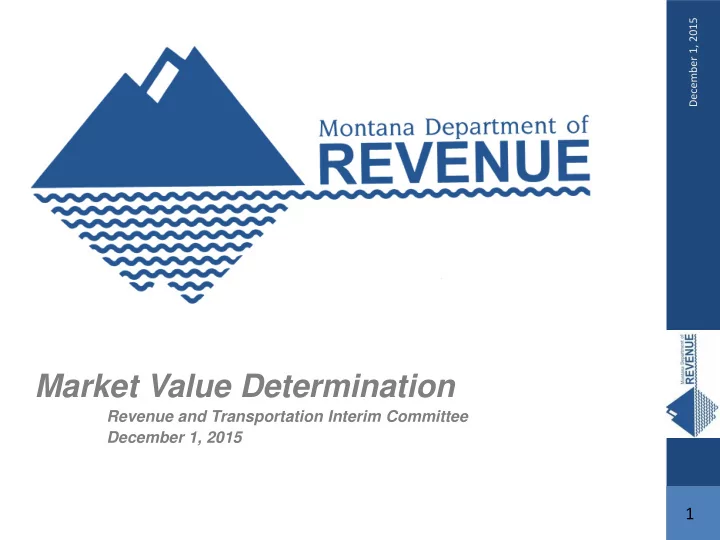

December 1, 2015 Market Value Determination Revenue and Transportation Interim Committee December 1, 2015 1
December 1, 2015 Overview • Why Reappraisal? • Discuss the Approaches to Value • Specific Discussion on Approaches to Value 2
December 1, 2015 Why Reappraisal? • Requires all property to be valued by the state • Equalization - the state is required to value similar property in the same manner Constitution • The law requires the state to value all property periodically • All taxable property is required to be valued at 100% market value except as determined otherwise. The Law 3
December 1, 2015 Valuation Methods or Approaches Market value of property can be determined using three methods: Cost Income Market 4
December 1, 2015 Cost Approach The Cost approach seeks to determine how much a property would cost to replace (meaning, rebuild) less accrued depreciation. Accrued depreciation is the reduction in actual value of property over a period of time as a result of wear and tear or obsolescence. Reproduction cost is used if an exact replica of the original property is produced. Replacement cost is used if a property is rebuilt with comparable utility, but using current design and construction methods and materials. 5
December 1, 2015 Income Approach The Income approach seeks to value property using the income generated by the property. When a property generates income for it’s owner, that income, or potential for income, helps to substantiate, calculate or identify the market value of the property. Apartment buildings and duplexes are examples of income-producing properties. 6
December 1, 2015 Market or Sales Comparison Approach The Market or Sales Comparison approach bases the opinion of value on what similar properties (otherwise known as “comparables”, or “comps”) in the vicinity have sold for recently. These properties are adjusted for time, acreage, size, amenities, etc. as compared to the property that is being appraised. Understanding which (and to what extent) adjustments are reasonable for a given market area (for a given property) relies on the experience of the appraiser. A property characteristic that is highly valued in one neighborhood may not be valued to the same degree in a different area. 7
December 1, 2015 Valuation Methods Used by the Department by Property Type Sales Approach Residential Cost Approach Sales Approach Commercial Cost Approach Industrial Centrally Assessed Income Approach Income Approach Agricultural Forest Income Approach 8
9 December 1, 2015
December 1, 2015 Comparing Subject Property to Comparable Property Comparable Property Characteristics Age, Condition, Desirability, etc. Comparable Subject Comparable Property Property Similar Structure Property locational Type/Use influences Comparable Property Property rights Fee Simple 10
December 1, 2015 Cost Approach to Value Primarily Residential and Commercial Property Land Value + Improvement Cost – Depreciation = Market Value 11
December 1, 2015 Income Approach Commercial Property Income – Expenses = Market Value Rate of Return 12
December 1, 2015 Agricultural Land Valuation – Income Approach Productivity Value = (land productivity X commodity price X crop share) rate of return Productivity Determined: • Natural Resource Conservation Service (NRCS) Soil Survey and • Adjustments when appropriate to approximate average production 13
December 1, 2015 Commodity Price • 10 Year Olympic Average • Grazing Land • Private Grazing Fee • Non-irrigated farm land (Summer fallow and continuous crop farmland) • Spring wheat • Irrigated and non-irrigated hay land • Spring Wheat or Alfalfa Hay 14
Commodity Prices December 1, 2015 ( Current vs. 2015 Prices) 2015 (10 Year Olympic Average) Indicates price not included in Average Commodity Spring Wheat Alfalfa Private Grazing Fee Year Price Price Price 2013 $6.70 $141.00 $21.00 2012 $8.39 $146.00 $20.50 2011 $8.36 $98.00 $19.40 2010 $6.87 $79.00 $18.40 2009 $5.72 $96.00 $18.00 2008 $7.36 $117.00 $18.10 2007 $7.49 $79.00 $17.80 2006 $4.58 $78.00 $16.20 2005 $3.80 $71.00 $16.20 2004 $3.69 $77.00 $15.90 Olympic Avg $6.36 $95.63 $18.08 15-7-202 stipulates a 20% reduction in the Adjustments No adjustment alfalfa price No adjustment 2015 Price $6.36 $76.50 $18.08 2009 Price $4.58 $63.04 $15.72 15 % change from current cycle 39% 21% 15%
December 1, 2015 Agricultural Values - Example Productivity Value = (land productivity X commodity price X crop share) rate of return Summer Fallow Farmland ( Wheat ) Land Productivity = 22 bu./ac Average price for spring wheat = $6.36 /bu. Crop Share = 12.5% Rate of Return (Capitalization Rate) = 6.4% $273.28/acre = 22 (bu./ac) X $6.36 (/bu.) X 12.5% 6.4% 16
Forest Land Valuation – Income December 1, 2015 Approach Productivity Value = ((forest productivity x stumpage value) + net agri. income) rate of return 17
December 1, 2015 Estimated Change in Forest Property Value Average 2009 2015 Zone Productivity value/Acre value/acre % change 1 260.75 $938.00 $436.53 -53% 2 170.86 $421.00 $251.71 -50% 3 154.22 $307.00 $171.56 -44% 4 129.18 $195.00 $32.52 -83% 18
Taxable Value Neutrality December 1, 2015 Example of Taxable Value Neutral Rates Property 2014 Market Value 2015 Taxable Ex. Market 2016 Markert TY 2016 Tax 2016 Taxable Type (in TY 15) Value Value Growth Value Rate Multiplier Value (a) (b) (c) (d) (e) (f)** (g)=(b) Example only (a)x(1+c) (b)÷(d)* (d)x(e)x(f) Agricultural $6,263.221 $141.391 3.20% $6,463.644 2.19% 1.00 $141.391 Residential $88,145.323 $1,176.971 2.50% $90,348.956 1.30% 1.00 $1,176.971 Commercial $19,428.062 $362.966 $20,418.894 1.30% 1.36 $362.966 5.10% *For commercial properlty, the tax rate is equal to the residential rateand then a multiplier is calculated. The multiplier is equal to (b÷d)÷(e). 19
December 1, 2015 2017 Reappraisal Timeline 20
December 1, 2015 Questions? 21
Recommend
More recommend